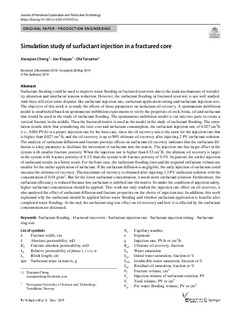| dc.contributor.author | Cheng, Xiaoqian | |
| dc.contributor.author | Kleppe, Jon | |
| dc.contributor.author | Torsæter, Ole | |
| dc.date.accessioned | 2019-10-01T06:22:49Z | |
| dc.date.available | 2019-10-01T06:22:49Z | |
| dc.date.created | 2019-07-02T14:00:21Z | |
| dc.date.issued | 2019 | |
| dc.identifier.citation | Journal of Petroleum Exploration and Production Technology. 2019, 1-12. | nb_NO |
| dc.identifier.issn | 2190-0558 | |
| dc.identifier.uri | http://hdl.handle.net/11250/2619463 | |
| dc.description.abstract | Surfactant flooding could be used to improve water flooding in fractured reservoirs due to the main mechanisms of wettability alteration and interfacial tension reduction. However, the surfactant flooding in fractured reservoir is not well studied. And there still exist some disputes like surfactant injection rate, surfactant application timing and surfactant injection size. The objective of this work is to study the effects of those parameters on surfactant oil recovery. A spontaneous imbibition model is established based on spontaneous imbibition experiments to verify the properties of rock, brine, oil and surfactant that would be used in the study of surfactant flooding. The spontaneous imbibition model is cut into two parts to create a vertical fracture in the middle. Then the fractured matrix is used as the model in the study of surfactant flooding. The simulation results show that considering the time cost and surfactant consumption, the surfactant injection rate of 0.027 cm3/h (i.e., 0.001 PV/h) is a proper injection rate for the base case, since the oil recovery rate is the same for the injection rate that is higher than 0.027 cm3/h, and the oil recovery is up to 90% ultimate oil recovery after injecting 2 PV surfactant solution. The analysis of surfactant diffusion and fracture porosity effects on surfactant oil recovery indicates that the surfactant diffusion is a key parameter to facilitate the movement of surfactant into the matrix. The injection rate has larger effect in the system with smaller fracture porosity. When the injection rate is higher than 0.53 cm3/h, the ultimate oil recovery is larger in the system with fracture porosity of 0.1% than the system with fracture porosity of 0.5%. In general, the earlier injection of surfactant results in a better result. For the base case, the surfactant flooding time and the required surfactant volume are smaller for the earlier application of surfactant. If the surfactant diffusion is negligible, the early injection of surfactant could increase the ultimate oil recovery. The maximum oil recovery is obtained after injecting 1.3 PV surfactant solution with the concentration of 0.01 g/cm3. But for the lower surfactant concentration, it needs more surfactant solution. Furthermore, the surfactant efficiency is reduced because less surfactant is imbibed into the matrix. So under the condition of injection safety, higher surfactant concentration should be applied. This work not only studied the injection rate effect on oil recovery, it also analysed the effect of surfactant diffusion and fracture properties on the choice of injection rate. In addition, this work explained why the surfactant should be applied before water flooding and whether surfactant application is feasible after completed water flooding. At the end, the surfactant slug size effect on oil recovery and how it is affected by the surfactant concentration are discussed. | nb_NO |
| dc.language.iso | eng | nb_NO |
| dc.rights | Navngivelse 4.0 Internasjonal | * |
| dc.rights.uri | http://creativecommons.org/licenses/by/4.0/deed.no | * |
| dc.title | Simulation study of surfactant injection in a fractured core | nb_NO |
| dc.type | Journal article | nb_NO |
| dc.type | Peer reviewed | nb_NO |
| dc.description.version | publishedVersion | nb_NO |
| dc.source.pagenumber | 1-12 | nb_NO |
| dc.source.journal | Journal of Petroleum Exploration and Production Technology | nb_NO |
| dc.identifier.doi | 10.1007/s13202-019-0705-y | |
| dc.identifier.cristin | 1709437 | |
| dc.relation.project | Norges forskningsråd: 262644 | nb_NO |
| dc.relation.project | Norges teknisk-naturvitenskapelige universitet: 81770702 | nb_NO |
| dc.description.localcode | © The Author(s) 2019 Open Access This article is distributed under the terms of the Creative Commons Attribution 4.0 International License (http://creativecommons.org/licenses/by/4.0/), which permits unrestricted use, distribution, and reproduction in any medium, provided you give appropriate credit to the original author(s) and the source, provide a link to the Creative Commons license, and indicate if changes were made. | nb_NO |
| cristin.unitcode | 194,64,90,0 | |
| cristin.unitname | Institutt for geovitenskap og petroleum | |
| cristin.ispublished | true | |
| cristin.fulltext | original | |
| cristin.qualitycode | 1 | |

